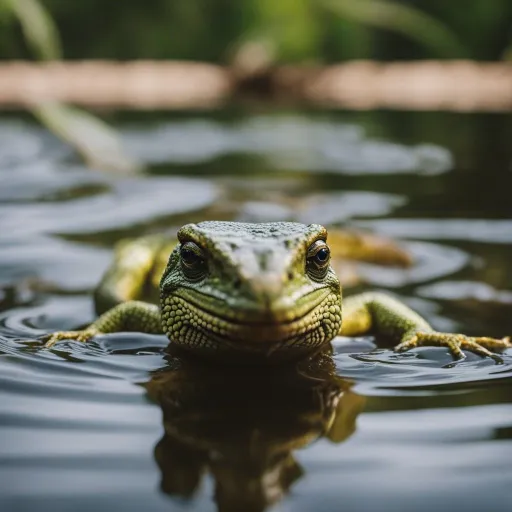
Have you ever wondered why lizards’ throats turn red? It’s a fascinating phenomenon that has puzzled scientists for years.
In this article, we will explore the possible reasons behind this intriguing color change. From mating rituals to defense mechanisms, there are several theories that attempt to explain why lizards display this vibrant red hue in their throats.
So, let’s uncover the secrets behind this mesmerizing transformation and discover the hidden world of lizard communication.
Why Do Lizards Throats Turn Red?
When you observe lizards, one of the striking features you may notice is the vibrant red coloration of their throats.
The fascinating question arises: why do lizards’ throats turn red? In this article, we will explore the various reasons behind this intriguing phenomenon.
From the definition of throat color in lizards to the influence of environmental factors and the role of throat color in communication and reproduction, we will delve into every aspect to provide you with a comprehensive understanding.

Definition of Throat Color in Lizards
To understand why lizards’ throats turn red, let us first define what throat coloration means in lizards. The throat, also known as the dewlap, is a skin flap located beneath the chin and extending to the chest area of lizards. Throat coloration refers to the pigmentation or hue observed in this particular region. The color can vary greatly among different lizard species, ranging from vibrant reds, oranges, and blues to more subtle shades like pale yellows and greens.
Variety of Lizard Species
Lizards are a diverse group of reptiles, with thousands of species inhabiting various ecosystems worldwide. Interestingly, not all lizard species exhibit red throats. Some lizards have red throats, while others exhibit different colors or uniform throat coloration. This variation among lizard species adds to the intrigue behind the reason for red throats in some lizards.https://www.youtube.com/embed/blXmYtPXrQ4
Role of Throat Color in Communication
Communication plays a vital role in the animal kingdom, and lizards are no exception. Throat coloration is an essential visual signal used by lizards to communicate with one another. This vibrant display helps lizards convey crucial information to their conspecifics, including potential mates, rivals, and even predators.
Throat color is particularly significant in attracting mates during the breeding season. Male lizards often showcase their brightly colored throats to visually entice females. The intensity and redness of the throat coloration are believed to play a role in female lizard’s preference for a potential mate.
Environmental Factors Affecting Throat Color
The environment plays a crucial role in determining the throat color of lizards. Various factors such as natural habitat, light intensity, ultraviolet (UV) exposure, seasonal changes, and even social hierarchy influence the pigmentation of a lizard’s throat.
Lizards that inhabit different environments may have distinct throat colors as a means of adaptation to their surroundings. For example, lizards living in green foliage environments may exhibit green or yellow throat coloration to enhance their camouflage. Contrastingly, lizards residing in arid habitats may display throat pigmentation that blends with their surroundings, such as reddish-brown or sand-colored throats.

Female Attraction and Reproduction
Throat coloration in male lizards serves as a visual cue to attract potential female mates. Females may prefer males with brighter and more intense red throats, as it may indicate the male’s overall health and genetic fitness. Studies suggest that male lizards with redder throats may have higher reproductive success and produce offspring with a higher likelihood of survival.
The redness of a male lizard’s throat is often associated with testosterone levels, which can influence various traits like aggressiveness, size, and overall fitness. Therefore, the redder the throat, the more attractive the male lizard may appear to females during the mating season.
Dominance and Territory
Throat coloration also plays a crucial role in establishing dominance among male lizards. In territorial displays, lizards use their vibrant throats to intimidate rivals and assert their dominance. The intensity and size of the red throat can serve as an indicator of a male’s social status and hierarchy within a population.
Competition among males for resources and mating opportunities can lead to intense displays of aggression. A male with a redder and more visually prominent throat may have an advantage in these confrontations, often deterring rivals and asserting its dominance within a given territory.
Temperature Regulation
The color of a lizard’s throat can also be influenced by its role in temperature regulation. As ectothermic creatures, lizards rely on external heat sources to maintain their body temperature. Throat coloration can impact the absorption and dissipation of heat, allowing lizards to regulate their body temperature effectively.
Dark-colored throats, including red, absorb sunlight more efficiently, helping the lizard raise its body temperature. In contrast, lighter colors reflect sunlight, assisting in heat dissipation and cooling mechanisms. Lizards can adjust their throat coloration according to their preferred body temperature, ensuring optimal functioning in various climates and environmental conditions.
Camouflage and Predation Avoidance
Throat color in lizards can serve vital functions in camouflage and predation avoidance. Some lizard species possess throat coloration that perfectly matches their surrounding environment, enhancing their ability to blend in and avoid detection by predators. This can act as a critical survival mechanism, enabling lizards to stay hidden and protected.
On the flip side, certain species exhibit bright red throats as a warning signal to potential predators. This signal indicates that the lizard is toxic or unpalatable, discouraging predators from attacking. The vibrant red color serves as a visual deterrent, highlighting the lizard’s unappealing nature and minimizing predation risk.
Dietary Influence on Throat Color
While environmental factors play a significant role in throat coloration, diet can also affect the vibrancy and hue of a lizard’s throat. Some lizards consume pigments present in their food, which can influence the coloration of various body parts, including the throat. Diets rich in carotenoids, a group of pigments obtained from consuming fruits and insects, can intensify the redness of a lizard’s throat.
Hormonal and Genetic Factors
Throat color in lizards is not solely influenced by environmental factors; hormonal and genetic factors also contribute to this phenomenon. Hormones, particularly testosterone, play a significant role in the development and maintenance of vibrant throat coloration in male lizards. Studies have shown that manipulating hormone levels can alter the intensity and duration of throat color display.
Additionally, genetic factors also contribute to the variation in throat color among different lizard populations. Research on genetic markers has provided valuable insights into the genes responsible for throat color variation in lizards. The intricate interaction between genetics and environmental factors further shapes the observable throat color in these reptiles.
Final Thoughts
In conclusion, the redness of a lizard’s throat serves multiple purposes, including communication, reproductive success, territorial displays, temperature regulation, predation avoidance, and even camouflage.
While various environmental, hormonal, genetic, and dietary factors influence throat coloration, the reasons behind the redness can vary depending on the species and their unique adaptations.
The vibrant throats of lizards captivate our curiosity and serve as a reminder of the intricate evolutionary processes that shape the natural world.



